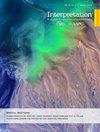准噶尔盆地马湖斜坡西部二叠系下乌尔河组含油气特征及控制因素
IF 1.1
4区 地球科学
Q3 GEOCHEMISTRY & GEOPHYSICS
Interpretation-A Journal of Subsurface Characterization
Pub Date : 2023-04-20
DOI:10.1190/int-2022-0122.1
引用次数: 0
摘要
马湖西斜坡下乌尔河组大量油气发现表明该地区可能存在潜在的含油气储层。然而,有关储层特征和相关控制因素的问题仍不清楚。为了确定这些储层的特征和相关控制因素,对三维地震体、电缆测井、泥浆测井、岩心、薄片、孔隙度和渗透率数据进行了综合分析。通过岩心、铸型薄片和泥浆测井资料,确定了几种岩性类型(包括泥岩、砂岩、重力流砂砾岩、过渡砂砾岩和牵引流砂砾岩)。根据铸体薄片数据确定接触关系,接触关系包括点接触和直线接触,其次是凹凸接触和缝合接触。孔隙类型以粒间孔为主,其次为粒内孔、基质内孔和裂缝。孔隙度和渗透率数据表明,砂岩和牵引流砂砾岩通常形成低孔低渗储层,过渡性砂砾岩通常形成低孔超低渗储层,重力流砂砾岩通常形成低孔超低渗储层。综合分析表明,构造运动和沉积环境控制着储层物性。构造运动通过逆冲断裂体系和大规模物源控制储层特征,沉积环境通过相展布和湖泊起伏控制储层特征。研究结果为准噶尔盆地西部二叠系下乌尔霍组储层特征及控制因素提供了依据。这些发现也有助于研究区域的油气储量和油气生产勘探,以及其他具有类似沉积/构造环境的地区的进一步石油勘探。本文章由计算机程序翻译,如有差异,请以英文原文为准。
Characteristics and controlling factors of petroliferous reservoirs in the Permian Lower Urho Formation, western Mahu Slope, Junggar Basin, NW China
Numerous hydrocarbon discoveries in the Lower Urho Formation of the western Mahu Slope, China indicate that potential petroliferous reservoirs may exist in that region. However, issues concerning the reservoir characteristics and associated controlling factors remain unclear. To determine the characteristics and associated controlling factors of those reservoirs, an integrated analysis of three-dimensional seismic volume, wireline logs, mud logs, cores, thin sections, porosity, and permeability data was conducted. Several lithological types were identified from the core, casting thin section, and mud log data (including mudstone, sandstone, gravity flow-derived glutenite, transitional glutenite, and traction flow-derived glutenite). The contact relationship was determined from the casting thin section data, and it included point contact and lineal contact, followed by concavo-convex contact and suture contact. The dominant pore types were found to be intergranular pores, followed by intragranular pores, intramatrix pores, and cracks. The porosity and permeability data reveal that sandstone and traction flow-derived glutenite commonly form low-porosity and low-permeability reservoir, whereas transitional glutenite commonly forms low-porosity and ultralow-permeability reservoirs and gravity flow-derived glutenite generally forms low-porosity and ultralow-permeability reservoirs. This integrated analysis shows that tectonic movements and sedimentary environment control the physical properties of the reservoirs. The tectonic movements control reservoir characteristics through thrust fault systems and the large-scale provenance, and the sedimentary environment controls reservoir characteristics via facies distribution and lacustrine fluctuation. The insights gained from this study can provide knowledge about the characteristics and associated controlling factors of the reservoirs in the Permian Lower Urho Formation within the western Junggar Basin. These insights can also benefit petroleum reserve and hydrocarbon production exploration in the study area and further petroleum exploration in other areas with similar sedimentary/tectonic settings.
求助全文
通过发布文献求助,成功后即可免费获取论文全文。
去求助
来源期刊

Interpretation-A Journal of Subsurface Characterization
GEOCHEMISTRY & GEOPHYSICS-
CiteScore
2.50
自引率
8.30%
发文量
126
期刊介绍:
***Jointly published by the American Association of Petroleum Geologists (AAPG) and the Society of Exploration Geophysicists (SEG)***
Interpretation is a new, peer-reviewed journal for advancing the practice of subsurface interpretation.
 求助内容:
求助内容: 应助结果提醒方式:
应助结果提醒方式:


